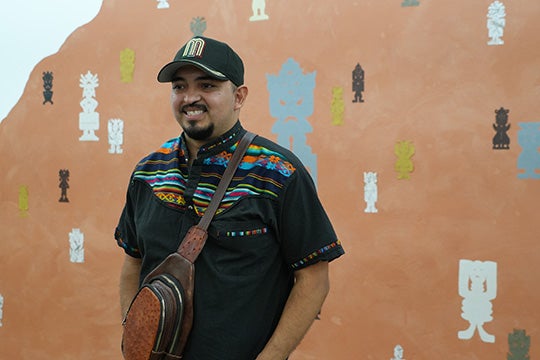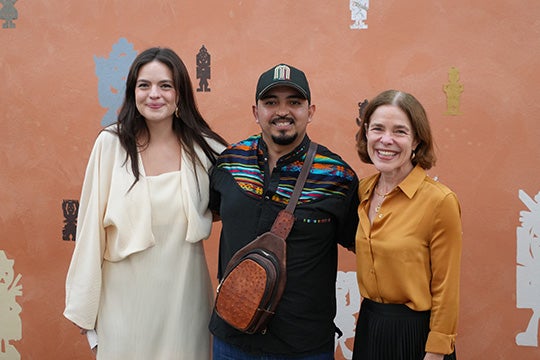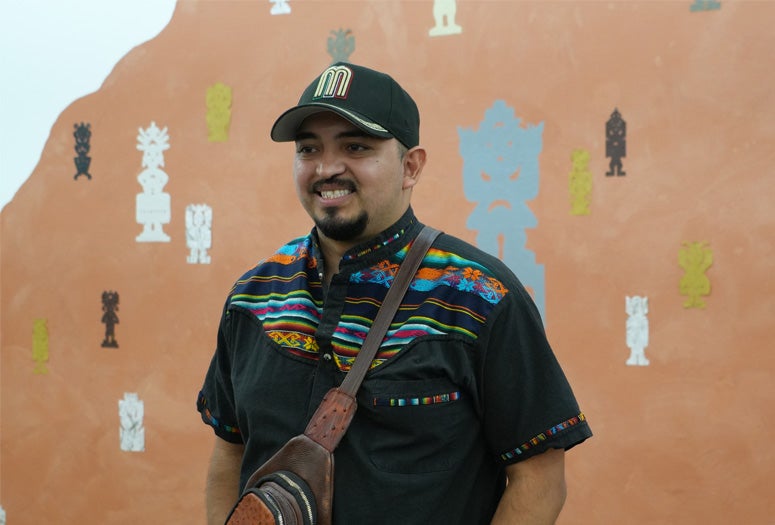Houston artist Guadalupe Hernandez has long turned memory into material. Through paper, pigment and ritualized collaboration, he preserves and reimagines his Mexican heritage. This fall, the artist was commissioned by Rice University’s Moody Center for the Arts to work with Rice students to realize a large-scale mural as a part of their Moody Project Wall series. The work titled “Hijos de la Virgen morena” extends his practice and thematic focus to a new generation.

The mural, on view in the Moody’s Flex Studio, depicts a textured hill made of clay layered with papel picado figures that recall deities of both Catholic and Indigenous origin. The site itself nods to Tepeyac Hill, once home to a temple dedicated to the Aztec goddess Tonantzin, where the Virgin of Guadalupe is said to have appeared in 1531. By merging those Indigenous and European cosmologies, Hernandez reveals the cultural negotiations embedded in faith. In a series of workshops, Hernandez shared these histories and iconographies as well as the craft of papel picado with Rice students.
“Throughout the month of September, we’ve collaborated with the Rice students to create this installation that is a depiction of the Tepeyac, which is where the Virgin of Guadalupe appeared to Juan Diego,” Hernandez said. “I work with papel picado, which is the traditional Mexican folk art of punch paper. It really originates from the tradition of papel amate, which the Indigenous people would make out of the bark of fig trees. They would create codices out of it. They would punch out these figures.”
The collaboration unfolded in three stages, each one deepening the link between process and meaning. In the first week, students punched out the idols. The following week they painted the silhouette of Tepeyac Hill, and in the third, the fragments coalesced into the finished mural, a ritual of assembly as much as artmaking.
“The inspiration for this really kind of came from an investigation into my namesake,” Hernandez said. “I was named after the Virgin de Guadalupe. As I investigated more of the history, I found connections between the Indigenous traditions and how the Catholics use that to convert the Indigenous people.”

The students’ figures — rendered in charcoals and ochre yellows — float across the clay-painted Tepeyac as a chorus of divine offspring, embodying Tonantzin’s enduring attributes of motherhood, fertility and protection. Each cut and pigment is a gesture of lineage, linking pre-Columbian craft to contemporary expression.
The Moody Project Wall was launched in 2021 to foster collaboration between Houston artists and Rice students. Organized by associate curator Noor Alé, Hernandez’s contribution captures that mission perfectly: a space where heritage, community and learning converge. The work stands not just as a visual homage to the Virgin of Guadalupe and Tonantzin but as a living record of how belief and art adapt — hand to hand, cut by cut — across time.
“Hijos de la Virgen morena” will be on view at the Moody through Dec. 20. Learn more about it here.

